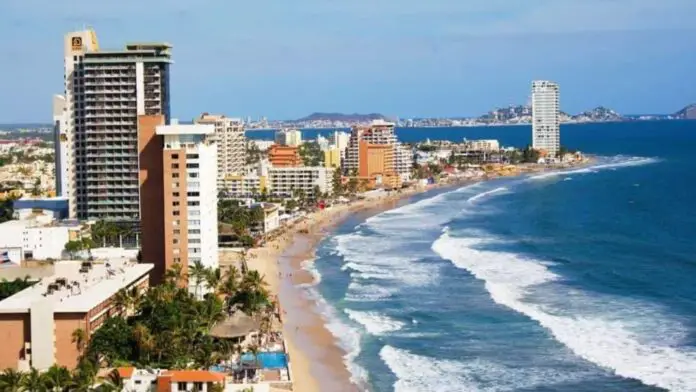The conflict between Los Chapitos and El Mayo’s allies has reached Mazatlán, Sinaloa’s tourist gem. The city witnessed a night of terror due to this confrontation between cartels. Authorities have requested that citizens remain safe following the violence. A total of 25 deaths were reported over the weekend in Sinaloa, surpassing any other state. Mazatlán, which is known as the main tourist destination in Sinaloa, has become a war zone. The city experienced shootouts, drug blockades, and murders, spreading panic among its residents.
This escalation of violence comes eight weeks into ongoing hostilities between Los Chapitos and El Mayo’s allies. Initially, Culiacán was at the epicenter of this conflict; however, it has now spread to other municipalities like Elota, Concordia, Navolato, and San Ignacio. Mazatlán is no exception, with a child crying in fear for his safety and people taking shelter in supermarkets being among the dramatic images captured during this period.
According to reports from the state prosecutor’s office, there were 14 homicides on Saturday alone in Mazatlán. The federal government confirmed 13 murders on that day, while another 12 occurred on Sunday. Governor Rubén Rocha Moya stated that it is possible for cells of these groups to be present in Mazatlán and urged citizens to stay safe.
The city had seen violence before this escalation. Three weeks ago, criminal organizations stole the vehicle of the then-elected mayor, Estrella Palacios. In a previous incident, an active municipal police commander was killed while driving with his wife. The state’s tourism industry has been significantly impacted by these events, with Mazatlán receiving over 5.4 million tourists in 2023 and generating approximately 6.5 billion pesos during the summer vacations.
The governor, Rubén Rocha Moya, announced an expansion of security forces in Mazatlán but did not provide details on the number of elements to be deployed. The Autonomous University of Sinaloa, with over 70,000 students in the state, decided to suspend in-person classes at its port campus due to the rising violence.
The blockade of a highway between Mazatlán and Durango was also reported, with a burning trailer blocking traffic. This incident has increased concerns about the safety of residents and visitors alike. The war for control of the Sinaloa Cartel has left over 200 deaths since its beginning on September 9, with hundreds of robberies and forced disappearances reported.
The state’s Attorney General’s Office reported that more than 250 people have been kidnapped, with 86 found alive, 31 dead, and 135 still missing. This violence has manifested itself in the main highways and roads of Sinaloa, as well as in the busiest avenues of Culiacán. President Claudia Sheinbaum stated that the authorities are working to restore peace in Sinaloa and blamed the United States for the state’s insecurity following the capture of El Mayo in New Mexico at the end of last July.
The situation has led to a significant impact on the city, with people seeking shelter from the crossfire. The government has assured citizens that they are taking measures to ensure their safety, but the escalating violence has left residents and visitors alike feeling vulnerable. As the conflict between Los Chapitos and El Mayo’s allies continues, Mazatlán remains a city in turmoil, with its residents struggling to cope with the situation.
The war for control of the Sinaloa Cartel has had far-reaching consequences for the state and its people. The violence has spread beyond the city limits, affecting other municipalities and leaving a trail of destruction in its wake. As the government works to restore peace, the citizens of Mazatlán can only hope for an end to this cycle of violence and a return to normalcy.
In light of these events, the federal government’s response to the situation in Sinaloa has been called into question. The president’s blame on the United States for the state’s insecurity has sparked debate about the role of external factors in the conflict. However, it is clear that the root causes of this violence lie within the internal dynamics of the cartels and their struggle for power.
The people of Sinaloa deserve to live without fear of violence and intimidation. The government must take decisive action to bring an end to this cycle of bloodshed and restore peace to the state. Only through concerted efforts can the situation in Mazatlán be turned around, and the city’s residents can once again feel safe and secure.
The conflict between Los Chapitos and El Mayo’s allies has highlighted the need for a comprehensive approach to addressing the root causes of violence in Sinaloa. The government must work with all stakeholders to develop a long-term strategy that addresses the social, economic, and security issues driving this conflict.
In the meantime, citizens of Mazatlán and visitors alike should remain vigilant and take necessary precautions to ensure their safety. The situation on the ground is fluid, and it is essential to stay informed about the latest developments and follow the guidance of local authorities.
As the situation in Sinaloa continues to unfold, it is clear that this conflict has far-reaching implications for the state and its people. Only through a concerted effort can we hope to bring an end to this cycle of violence and restore peace to Mazatlán and the surrounding areas. The road ahead will be challenging, but with determination and a commitment to finding solutions, there is hope for a brighter future.
Source: El Pais






